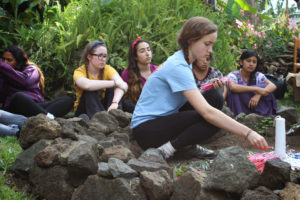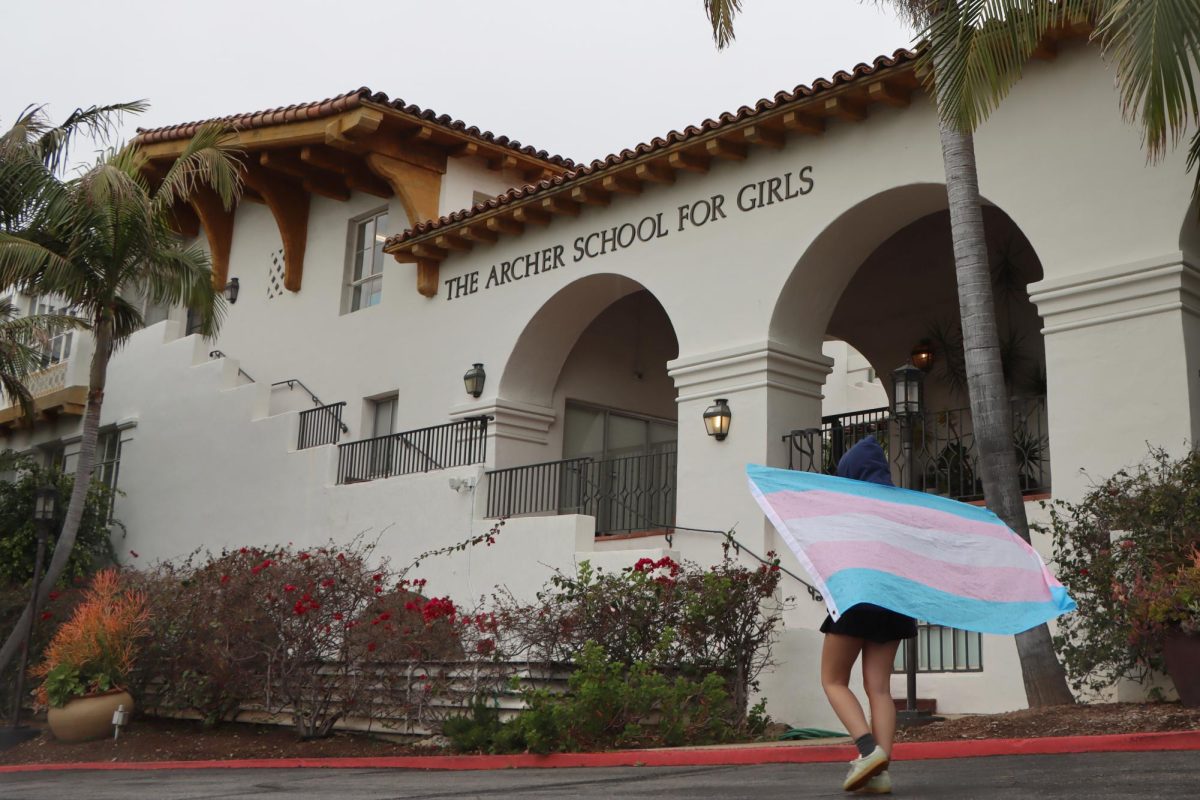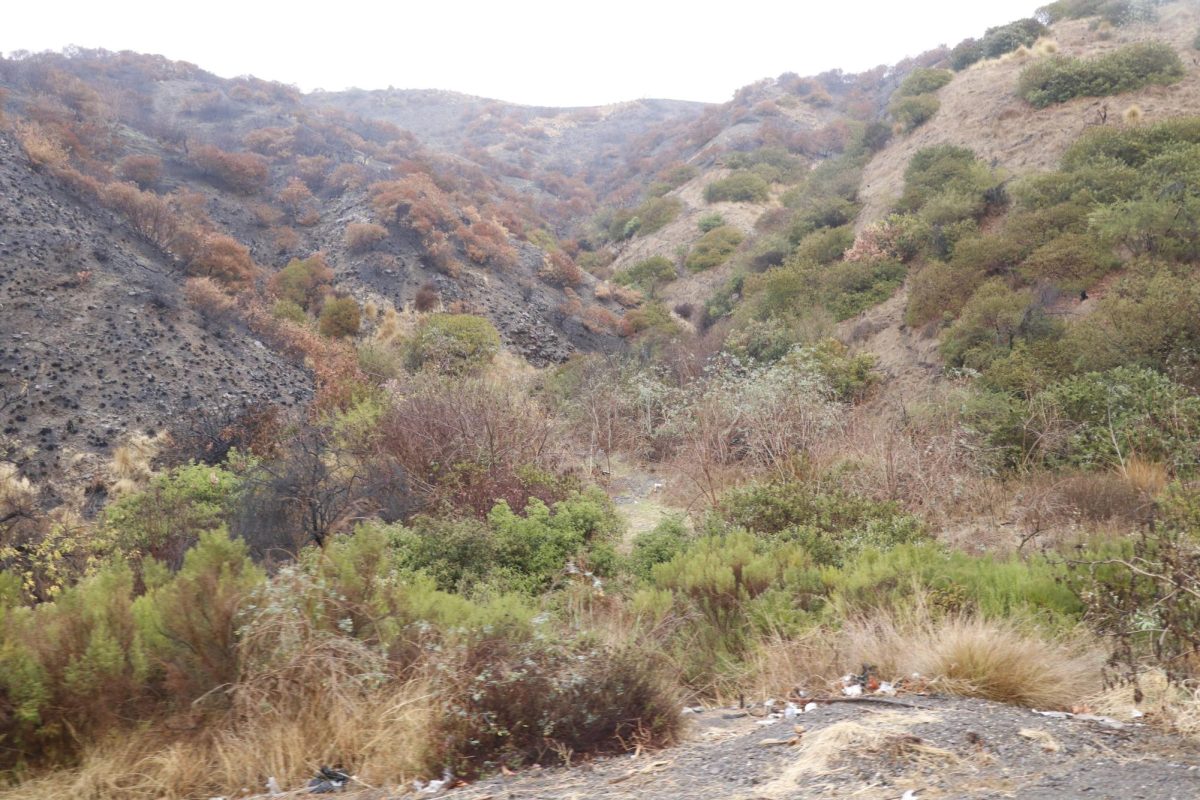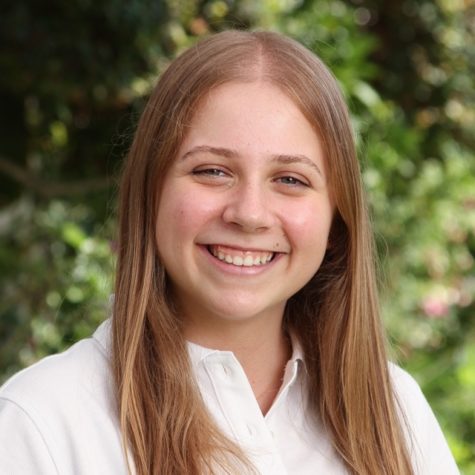On Nov. 20 at Los Angeles International Airport, 13 eager Archer girls boarded a 12:30 a.m. flight to Guatemala City, not knowing what to expect. Since May, the small group of Archer sophomores and juniors had been preparing for that very night by watching documentaries about Guatemalan history, reading about how to be a good traveler, and studying up on permaculture. All of their preparation led to this moment.
Although it is virtually impossible to cover a jam-packed, ten-day course in just one story, here are the highlights from this trip.
After a six-hour flight, the girls and Archer teachers Travis Nesbitt and Sue Sullivan landed in Guatemala City. Then, they took an hour-long bus trip to Antigua Guatemala. The travelers gazed out of their windows with sleepy eyes to see colorful buildings and looming volcanoes.
Even after a long flight, the girls were ready to explore Antigua. They headed to the Santa Clara Convent, where they took a tour of the convent and had a brief introduction to the course. That was where it all began. Sitting in an abandoned church in the heart of Antigua, the students learned how to live their lives in Guatemala.

Photographer: Travis Nebitt
The next day was a busy one, consisting of a tour of a macadamia nut farm, a history debate, and a scavenger hunt in Antigua. Instead of hearing a lecture about the Guatemalan civil war, the girls got to live it. They debated the issues of the time and discussed how these issues are still present in the country today.
After a short stay in Antigua, the group packed their bags and headed for San Lucas Tolimán, a little town on Lake Atitlan. There, they were welcomed to the Pavarotti School, where they would be staying for the bulk of the trip.
The girls had been looking forward to the next day when two girls from the Pavarotti school would come to learn with them. When they arrived, the Archer students initiated some icebreaker games, all in Spanish. Eva Bombeck ’15 said, “The language barrier was really hard with the Pavarotti girls at first. But after doing some ice breakers with them, it got less awkward and I started to feel more comfortable using my Spanish.” Soccer was a subject that both the girls from Archer and Pavarotti could bond over.
That day was filled with learning and translating. They learned about the Mayan Cosmovision (how the Mayans see the world), permaculture, and how girls of the same age could be so different, yet so similar.

Photographer: Travis Nesbitt
What came next surprised everyone from Archer. The girls were given an opportunity to participate in a traditional Mayan Ceremony. Although the whole ceremony was in Kaqchikel and no one could understand a word, they agreed that they could all feel the emotions and energy given off by the ceremony.
The next day, six more girls from the Pavarotti school joined the Archer group on a hike from the school to the nearby permaculture center called IMAP, which stands for Instituto Mesoamericano de Permacultura (Institute of Mesoamerican Permaculture). That day was the first of many that the Archer girls would be traveling to IMAP. On that first day at IMAP, they learned as much as they could about permaculture. In permaculture, they learned, all elements of nature work together.
Emersorn Krull ’15 said, “I learned that permaculture is much more than an environmental process for the Indigenous people in Guatemala. It is a return to their roots and traditional ways of connecting to Mother Earth.”
The Archer girls were so inspired by permaculture that they decided to bring it back to Los Angeles. They wanted to take everything that they learned and share it with the community. Lucie Freeman ’15 said, “While in Guatemala, I learned that permaculture is not only a great way to sustain the environment but it is also so easy to do in your everyday life.”
The next day, all of the girls from Archer and Pavarotti hopped in the back of a pick-up truck, their favorite mode of transport. They went back to IMAP to take a permaculture cooking lesson. The girls made tortillas, tamales, amaranth seed candy, and a sauce from pumpkin seeds and used many seeds while cooking, which is a part of the plant that rarely gets used in regular cooking. They concluded that this tied back to the idea of optimizing the surplus, and not wasting a perfectly delicious and extremely important piece of nature.

Photographer: Travis Nesbitt
They spent the second half of the day back at the Pavarotti school. All of the girls built an herb snail for the school, a sustainable way to plant herbs. They learned that herbs that need the most sun and the least amount of water should be planted at the top of the snail (or spiral). The herbs that need the most shade and the most water are planted at the bottom of the spiral. In this way, the herbs are both benefitting and helping each other.
The next day, the travelers took a tour of a neighboring town, Santiago Atitlan, where they visited several religious sites where the Mayan religion had blended with Catholicism brought to Guatemala by the Spaniards.
Later that day, the students started their main project at a nearby school. The school had been abandoned for many years, and IMAP is currently working on getting it up and running again. That day was a clean up day. They picked up trash—layers and layers of trash—and cleared the over-grown garden to make room for a new one.
The next day was Thanksgiving. With a grateful attitude in mind, the students headed back to IMAP for one final work day.

They worked with the girls from Pavarotti as well as some employees from IMAP to set the foundation of a sink for the school to promote cleanliness and hygiene for the students there. Although none of the girls were plumbing experts, they managed to saw piping for the sink and measure the correct distance for the piping, not to mention counting and measuring in both Spanish and English.
That Thanksgiving was their last night in San Lucas, and to celebrate, the Archer students threw a party for the Pavoratti girls and everyone they had met along the way that made their journey in San Lucas so special.
Kimia Khatibi ’16 said, “I think the party meant as much to the Pavoratti girls as it did to us, because it was a time and place where we were able to bond with one another towards the end of the trip and have a nice closing to the entire experience with the lovely girls and friends we made there in San Lucas.”
Everyone sang, laughed, ate, and even played piñata. It was hard to say goodbye to their friends that they had gotten so close to.
In reflection, Dr. Nesbitt said, “It was a truly transformative trip and one in which the participants were rewarded for their openness, humility, curiosity, hard work and preparation. I’m sure it will resonate with the Archer girls for years to come.” Ms. Sullivan added, “This trip was transformative for me in a more profound way than other trips I have taken. We were able to immerse ourselves deeply in the culture and history of Guatemala, despite the short time frame. All the students were very engaged, and Ariel and Liz—our leaders from Dragons—provided excellent guidance.”
If you want to hear more about the amazing experience in Guatemala, come to the students’ Diversity Day seminar: “A Modern State of Mayan.”

Both the Archer girls and the Pavarotti girls posing in front of their herb snail.
Photographer: Travis Nesbitt











Judith Diesenhaus • Jan 29, 2014 at 8:11 am
What a wonderful recap of your trip. I’m visualizing your pictures all over again. Travel is the best way to learn about the peoples of the world. Archer girls are so fortunate to have these opportunities.
Ron Stone • Jan 27, 2014 at 12:14 pm
Great article! I know what an amazing and inspirational trip this was — great to see you and the Archer team bring back all that you learned in Guatemala to Los Angeles!
Ms. Sullivan • Jan 24, 2014 at 6:31 pm
Lovely article, Syd…and great photos….thanks, Dr. Nesbitt. It really made me want to be back in San Lucas!
beth gold • Jan 24, 2014 at 5:57 pm
Thanks for giving such a thorough and detailed recap of the trip Syd. I have a much clearer idea of what your experience in Guatemala was like now. What a wonderful opportunity to learn first-hand about Guatemala’s history and culture.